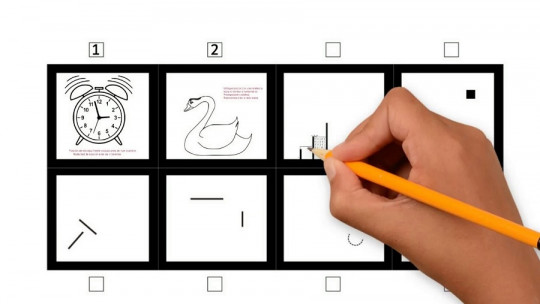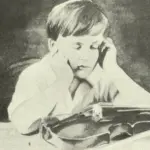
Psychological evaluation is an omnipresent process in practically all areas in which this discipline can be applied: clinical and health, sports, personnel selection, academic guidance, etc.
From it we can extract important information about the person after having previously defined a clear purpose, which will serve as a guide throughout the entire process and will define other variables that can be measured. This task includes an enormous variety of different procedures: from interviews to self-reports, through systematic observation of a phenomenon and objective measurements.
In this article we will describe the Wartegg test an evaluation tool classified as a projective test, whose use extends widely in the field of Organizational Psychology.
What is the Wartegg test
The Wartegg test is a projective test as well as the iconic and well-known Roscharch test (in which a set of ink blots on white sheets must be interpreted to construct a coherent image from a stimulus of great ambiguity, which would allow the evaluator to infer the basic aspects of the personality).
Its use arises from theoretical models that conceive the human being as an agent element in the construction of his reality, being able to give meaning to everything that happens to him through perceptive processes that combine experience and individuality. Thus, faced with a situation of notable lack of definition, people would articulate a unique perceptual result from which your desires and fears, your capabilities and aspirations could be inferred.
Next we will present what this well-known evaluation test is like. Its application is usually carried out in the context of personnel selection processes, often subject to criteria and requirements established in advance. It requires the drawing of eight different figures for which technical quality is not valued; but the implicit meaning of the strokes, the use of space and the integration of certain graphic elements.
What is the Wartegg test
The Wartegg test physically consists of a single page, which includes a set of elements that the evaluated subject will have to complete during the process. First of all, all the basic identification data appear at the top (full name, age, sex, date of completion, academic training and profession).
After completing this information, the test itself begins. We will access a rectangle crossed by a horizontal line and three vertical lines, which divide it into 8 spaces of equal size (squares), where the free drawings will subsequently have to be drawn. Each one of them contains a series of strokes inside, lines or curves. In a position adjacent to each of the paintings, there is also a small white rectangle.
In the second half of the folio there are 8 numbered lines under the heading “drawing titles”, which must be completed by assigning a phrase that describes the content of each of the eight illustrations that were previously generated. At the end of this part you access four questions. These explore which drawings are considered favorites, as well as the degree of difficulty involved in drawing them.
How the Wartegg test is performed
This test requires between 25 and 35 minutes to fully complete; which includes identification, making the drawings and answering the different questions. The part that requires the most time is the preparation of the drawings, which can be addressed in the order in which it is considered appropriate, but clearly identifying the sequence chosen (by writing a number from 1 to 8 in a small rectangle, adjacent to the squares where it is drawn).
Each of the paintings contains a series of simple shapes (lines, curves or figures) that serve as a prior indication, and from which A drawing must be drawn that integrates them into its composition. 4 of these boxes (1, 2, 7 and 8) have curves inside, while the rest (3, 4, 5 and 6) have straight lines. Thus, the first will facilitate the creation of organic drawings (such as landscapes or animals) and the rest will suggest more artificial-looking content.
After making these drawings, the person is asked to title them. It does not have to be through a precise statement that describes its content, but you can also opt for more poetic or metaphorical elaborations. In any case, it should represent the way in which the person perceives his eight works, summarizing in a simple way how he sees them.
Finally, it must be indicated whether any of the images drawn during the drawing phase were especially easy or difficult, as well as your preference for any of them. In this point the personal assessment that emerges from the development of the test is explored, which also provides relevant information for its proper interpretation. After this step, the exercise can be finished.
How to interpret the Wartegg test
This test explores essential aspects of personality using the precepts of the psychodynamic model. It includes the management of emotions, interpersonal relationships, expectations or ambitions, the solidity of the life project, the analysis of situations and values.
One of the first aspects that must be considered is the degree to which the person integrates the pre-established line or curve with the drawing he or she subsequently created since there are subjects who overstate their relevance and others who practically ignore their presence, suggesting a certain tendency towards anarchy or firm following of the rules (respectively).
The author of this test (Ehrig Wartegg, 1930) considered that the structure of each of the contents to be treated (lines or curves) was a meeting point with executive problems that had to be solved, dealing with its physical properties and what These could suggest to the person evaluated: lightness, weight, rigidity, chaos, order, tension between opposites, triviality, centrality, etc.).
We proceed to present each of the eight fields and a brief review of the way in which their interpretation is carried out.
Field 1
It only shows a small point in the center of the space on which the drawing will be made. It represents individuality, the way in which the person feels about the environment that surrounds them. The wide white margins that surround the tiny dot represent everything external, what is different from the person themselves, while that evidences the identity in immersion with the environment.
Field 2
Displays a subtle curved line in the upper left quadrant of the field to be filled, similar to the “ñ” tilde. This part explores the affective component of relationships, that is, the way in which the person shows themselves emotionally to others. Depending on the respect for the spaces reserved for the symbol, the positive or negative valence of the ties that develop in the social domain will be interpreted.
Field 3
It represents three straight lines located successively and parallel, of increasing length, in the lower left quadrant of this field. It refers to ambition and the desire for growth. The way in which the person takes advantage of each of these lines, as well as the continuity solution proposed for progression (continuing or interrupting it), will offer information about how expectations are projected into personal challenges.
Field 4
It is a small square, black, arranged in the upper right quadrant of the field. Through this figure, the relationship with the unconscious and the ability to develop deep cognitive content at the level of the imagination is explored. The way in which this small geometry is integrated with the drawing suggests emotions of anguish or tranquility, as well as maturity or immaturity in strategies to address emotional problems.
Field 5
These are two separate diagonal lines, located in the lower left quadrant, whose convergence would form an X. Assess energy regulation and the tendency to act. The way the drawing is made may suggest tendencies toward hostility or overt aggression, self-directed or heterodirected. When the figures are properly preserved, they are suggestive of a person with dynamism and an appropriate sense of initiative.
Field 6
It is made up of two small straight lines, one horizontal and the other vertical, which are located in the upper half of the painting. Both forms seem to suggest a certain sensation of spatial continuity, which the person can take advantage of to seek a complete closure of the figure. In this case, reasoning and the role of intellect for the evaluated subject are valued. It also specifies the ability to synthesize and discriminate what is relevant from what is irrelevant.
Field 7
It shows a linear succession of points that make up a crescent with an opening in its upper region, located within the lower right quadrant. Explore the subtlest aspect of sensitivity, even basic eroticism. It contemplates dedication, openness to others and aesthetic values, as well as the tendency to show attitudes of social care in interactions with others. The way in which the stippling is respected or not will suggest gentleness or harshness.
Field 8
It is formed by a long and marked curve, which extends transversely and occupies a good part of the upper half of the frame. It evaluates the tendency to seek protection, as well as the relationship that the individual maintains with their parents and the tendency to seek protection in the group. The drawing generated from this predefined shape will indicate the way the person feels about their ability to transcend adversity.
Final considerations
The Wartegg test is subject to constant reliability and validity testing including the interjudge modality, to determine if its use can provide useful information to understand personality structure.








